
One of the North Sea’s largest decommissioning projects appears to be nearing completion, with the removal of over 36,000 tonnes of material, intended to be recycled in the next 18 months, according to Abu Dhabi National Energy Company PJSC, which announced progress on the topside removal of the Brae Bravo platform on 13 August.
The firm described the Brae Bravo removal and disposal project as “ground-breaking”, and praised the efforts of contractors HAF (the Heerema Marine Contractor) and AFOD (AF Offshore Decom).
It was completed by two of the world’s largest semi-submersible crane vessels, Thialf and Sleipnir. At its peak, up to 500 people worked on the project totalling nearly 400,000 man-hours without any major incidents recorded.
Campaign 1, executed from the Thialf, prepared the platform for removal and removed the cranes and helideck. During these activities, Sleipnir simultaneously completed the removal of the Brae Bravo flare tower, bridge and jacket marking the first time these two semi-submersible crane vessels converged in the North Sea. Campaign 2 saw the return of the Sleipnir to remove the remaining modules and transport them to the dismantling yard.
The 36,000-tonne structure was sent to the AFOD Environmental Base in Vats, Norway, and is now being processed with the aim of reusing or recycling 95% or more of the material.
Commenting on this significant milestone, Donald Taylor, TAQA Managing Director for Europe, described the Brae Bravo decommissioning project as “a landmark moment for both TAQA and the North Sea offshore industry”. He said: “The scale of this engineering feat cannot be overstated. Despite the challenges faced by the on and offshore team of the COVID-19 pandemic, this was completed on schedule and without any major incidents recorded – highlighting our commitment to health and safety.”
“Decommissioning and late-life management of offshore assets will play a major role in our journey to a lower carbon future, and Brae Bravo will be the blueprint for all future TAQA decommissioning programmes in the North Sea.”
Over its 33-year lifetime, Brae Bravo produced more than 500 million barrels of oil equivalent and is widely recognised within industry as an iconic asset in the pioneering Brae fields.
The only remaining visible element of Brae Bravo is the top of the jacket above the sea surface. A dedicated navigational aid has been installed on the remaining structure and a 500-metre safety zone will remain in place until the jacket is decommissioned is in 2022.






